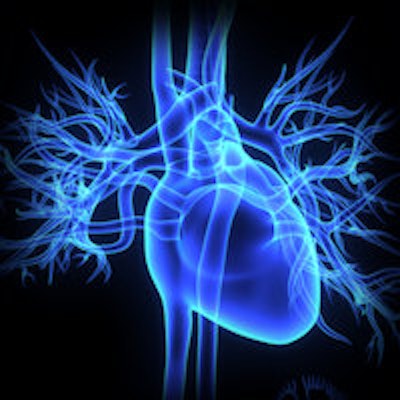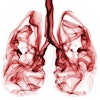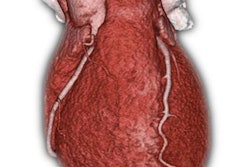
Three medical societies have unveiled new guidelines to standardize reporting for coronary CT angiography (CCTA), culminating a long multidisciplinary effort to bring more consistency to how these exams are reported and followed up.
The Coronary Artery Disease Reporting and Data System (CAD-RADS) will inform a procedure that examines millions of patients each year with suspected or known coronary artery disease (CAD), according to the recommendations released on June 15 by the Society of Cardiovascular Computed Tomography, the American College of Radiology, and the North American Society for Cardiovascular Imaging. The American College of Cardiology has also endorsed the system.
Before this effort, there was no standardized reporting scheme for CCTA, noted Dr. Ricardo Cury from the Miami Cardiac and Vascular Institute, who led a 17-member multidisciplinary expert consensus group to craft the guidelines for the benefit of the radiology, cardiology, and medical industry communities, according to a June 15 statement.
Suggested CAD-RADS classifications are applied on a per-patient basis and represent the highest-grade coronary artery lesion documented by coronary CTA, the group wrote. Classifications range from CAD-RADS 0 for complete absence of stenosis and plaque to CAD-RADS 5 to signify the presence of at least one totally occluded artery.
CAD-RADS classifications "should always be interpreted in conjunction with the impression found in the report," the authors wrote. They noted that specific recommendations are provided for further management of patients with stable or acute chest pain based on the classification. The goal is to facilitate communication of test results and communicate suggestions for subsequent patient management.
CAD-RADS will also "provide a framework of standardization that may benefit education, research, peer review, and quality assurance with the potential to ultimately result in improved quality of care," Cury and colleagues wrote.
Long overdue
Despite rapid advancements in CCTA and the burgeoning growth of the modality over past decades, no guidelines had been released for reporting findings to referring physicians, the authors wrote.
Other fields have produced guidelines to provide actionable information with test results, including, notably, breast imaging with BI-RADS. The BI-RADS classifications enable standardized reporting of screening mammograms and allow clinicians to interpret the clinical importance of findings and to take action. BI-RADS also supports registries and databases.
Other classification systems in place are LI-RADS for liver imaging, LUNG-RADS for lung cancer screening, and PI-RADS for multiparametric imaging in the context of prostate cancer.
Several major CCTA trials have recently been released, including the Prospective Multicenter Imaging Study for Evaluation of Chest Pain (PROMISE) and the Scottish Computed Tomography of the Heart (SCOT-HEART) trial, which showed that coronary CTA is clinically useful as an alternative to or in addition to functional testing, the authors wrote. Four earlier randomized trials that go by the acronyms CT-STAT, ACRIN-PA, ROMICAT II, and CT-COMPARE compared CCTA with the current standard of care in patients with acute chest pain.
Because the expert group perceived that each of those trials had limitations, such as an overrepresentation of low-risk patients, they decided instead to base the new reporting guidelines on expert consensus.
Recommendations, in brief
The CAD-RADS categories describe the most-occluded segment of a patient's CCTA scan and include recommendations for further investigation.
| CAD-RADS categories | |||||
| Category | Degree of maximal stenosis | Interpretation | Further investigation | ||
| 0 | 0% | No stenosis | None | ||
| 1 | 1%-24% | Minimal stenosis or plaque with no stenosis | None | ||
| 2 | 25%-49% | Mild nonobstructive CAD | None | ||
| 3 | 50%-69% | Moderate stenosis | Consider functional evaluation | ||
| 4 | 70%-99% | Severe stenosis | A. Consider functional evaluation. B. Invasive coronary angiography (ICA) recommended. | ||
| 5 | 100% | Total coronary occlusion | Consider ICA and/or viability assessment | ||
| N | Nondiagnostic | CAD cannot be excluded | Additional evaluation may be needed | ||
Recommended management
Patients with CAD-RADS 0 should be reassured that they do not have coronary artery disease, according to the authors. For CAD-RADS 0, 1, and 2, nonatherosclerotic causes of pain may also be investigated. For CAD-RADS 2 patients, preventive therapy and risk-factor modification should be considered, particularly for patients with nonobstructive plaque in multiple segments.
For CAD-RADS 3 and 4, doctors should consider symptom-guided, anti-ischemic, and preventive pharmacotherapy as well as risk-factor modification per guideline-directed care. Finally, other treatments should be considered as directed by the guidelines, the authors wrote. For CAD-RADS 4, physicians should also consider revascularization among the treatment options.
For CAD-RADS 5, clinicians should consider symptom-guided, anti-ischemic, and preventive pharmacotherapy along with risk-factor modification, as well as other treatments including revascularization options per guidelines.
Special care should be taken with regard to patients with previously known CAD. The main value of CCTA is in its high negative predictive value, the authors wrote. The positive predictive value of CCTA is lower, and the severity of many lesions may be overestimated. As a result, CCTA will need to be complemented by further tests.
CAD-RADS is meant to be "an evolving document that will undergo continuous updates as new data are acquired," Cury and colleagues concluded. "The main goal of CAD-RADS is to create report standardization terminology for coronary CTA results, and to improve communication of results to referring physicians in a clear and consistent fashion with a final assessment and suggestions for further management."
A proof of the full document can be downloaded via the Society of Cardiovascular Computed Tomography website. The document will also be published online in the Journal of Cardiovascular Computed Tomography, the Journal of the American College of Radiology, and JACC Cardiovascular Imaging.



















